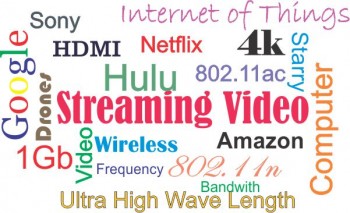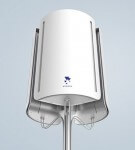The demand on today’s internet bandwidth is greater than it ever has been, with Pandora, Spotify, Netflix, Amazon Prime, Hulu 
This data is being delivered primarily through DSL and Cable which according to Cisco, one of the biggest network companies, is not even that reliable. It claims that right now internet outage is experienced by 43% of the population at least once a month.
If you rely on only streaming video, that kind of interruption can be a problem. I live in a community where my average client has between 1.5Mbps and 15Mbps of throughput and interruptions happen more frequently than that. I suspect many people are in this situation.

In today’s world, most of us have moved on from phone modems to Satellite, DSL or Cable. Some of us are even lucky enough to have fiber optic connections delivering a solid 1Gig of throughput. However, unless you live in a relatively large community, you may not have access to reliable high bandwidth providers. So what are our options?
Is Wireless the Future
Starry Wireless just announced a possible solution with their 1GB wireless internet service. Their service would deliver this data using “millimeter wave band active phased array”. Basically, they plan on using super high frequency wavelengths where data can be pushed through at very high speeds. As promising as this sounds, there are a lot of drawbacks to implementing this to the public and just how effective it will be won’t really be known until they roll out their first trial service in Boston then onto an additional 14 cities.


For starters, you would need to purchase their $349 receiver. The receiver comes with a built in antenna that just hangs out of a window. There will be a monthly fee as well but Starry has not been too forthcoming with the actual cost. They do claim that it would be considerably less than conventional cable rates. If I thought I could get 1GB service at a fraction of what I am paying for 50MB, the cost of the receiver, while steep, would not deter me. I would do it in a heartbeat.
However, there is more to the story, first of all your receiver must have “Line-of-Sight” to the transmitter. That would mean an incredible number of transmitters would have to be in place. Secondly, the service itself would be affected by the weather – heavy rain, thick clouds, and snow would almost certainly disrupt the service similar to the way satellite TV transmissions are affected (just how much of a disruption is not known at this time). Even that might not be a major problem for streaming video. A two-hour movie could be downloaded in just a couple of seconds. If you have access to a storage device to download and save the video, you could watch it offline with no interference, providing Netflix and other services would allow storage of any transmissions.
Not to be outdone, Google wants to test 1GB wireless using drones. They are currently testing devices in New Mexico. Even with the use of drones, I believe the system will still have similar limitations to the Starry device simply because it is wireless. You will still need line of site and inclement weather would also present a problem. In its application to the FCC Google said it will be using frequencies between 910 and 927MHz and another between 2.4GHz and 2.424GHz. this is different than their project Loon, released last year, which uses high altitude balloons that would suspend around 65,000 feet.
Too Early to Call
Just how effective any wireless internet service would be is still (like Google’s balloons) up in the air. Two wireless companies have already tried and failed and I don’t expect to see it anytime soon in my area. However, with companies the size of Google throwing money at the problem, it gives me hope that it will eventually become a reality.
There is no doubt in my mind that wireless internet providers will eventually make it happen and with companies like Sony pushing 4k streaming I think it will happen sooner than later. More and more of us are watching Netflix and other streaming video, if you don’t live in one of the larger metropolitan areas, wireless may be our only hope.

Interesting stuff especially when we consider rural customers with little chance of ever receiving a hardline connection, just wish they were more specific. Millimeter wavelength? Is that 1mm or 100mm – the difference in propagation and interference is hugely different?
The big plus I see to a system like Google’s loon is actually the “line of sight” issue as you can see much more from 65,000 ft than you can at ground level – and their frequency range is around 1GHz whereas a 10mm wavelength would be a frequency of 29GHz and much more susceptible to environmental conditions.
Dave, as far as Starry goes, I initially thought the same thing, I have a few friends that live in wine country in CA and there is no way any cable is going to reach them anytime soon. However, there is nothing Starry can link their transmitters. Everything looks like it is designed for metro use because all their transmitters would most likely be attached to high-rises. Their transmitter is small and might be able to get permission to put them on existing cell towers, that would be interesting. It also looks like Google is leaving loon to go with drones instead of balloons. I thought fuel would be the biggest issue but in some samples I saw, they look solar and would just glide in the very high thin air for long periods of time. It that is the case, that would make rural residences a target.
This goes way beyond my feeble knowledge of PC’s and internet connections. We are lucky to even have cable internet and have it working on any given day. This is interesting though.
Yea Dan but can you imagine downloading a full feature movie in less than 25 seconds. I have no doubt they will do it but don’t know if it will take 5 or 10 years to be inexpensive and available to people that have no other options. In my area, if I have to download a program, like Avast Free or Malwarebytes for some of my customers like Avast Free, it takes more that 15 min.
I think the biggest thing this would do is open the cloud as a viable storage where you could back up a terabyte in a reasonable amount of time.
We have the same problem for rural areas here in Australia. Considering our sparse population is spread over a vast area, probably even more so. This sounds like something which would be great for Australia but, as is usual with new technology/innovation, we will no doubt lag miles behind the US.
I get the nasty “system is buffering” message from some of my Roku apps, but rarely, if ever, from Netflix. I’m get around 30 Mbps on the download from my ISP; so if Netflix has no problem why do other apps (HBO-GO, Showtime,…) suffer from the dreaded buffering message?
Dan, if you are not getting buffering issues with Netflix ( I am assuming you are using Netflix on other than the Roku) and you are getting them with the Roku. I would suggest restarting the Roku player. Normally this would be done in conjunction with your wireless router but if it is hardwired and a last option you could perform a factory reset to the Roku Player. Depending on your model select Settings>System>Factory Reset. Alternately, you could use the reset button. Hold it for 20 seconds or until the front LED blinks rapidly a few times. Note: if you reset you will need to re-link the play to your account and reset passwords.I don’t know your model but you might want to try the debugging mode.. On the home screen enter : Home 5x, FF 3x, Rewind 2x Then choose “enable debug logging. Watch a few streaming videos and then note wht the actual speed the Roku reports. If you are still having a problem run “NameBench for Google. You can google it and select the right NameBench . This will allow you to ensure that you are using the best DNS for your situation.
Jim
Hi Jim,
Thanks for your detailed reply.
Before I try your suggestions, I should have been clearer that my Netflix app is installed on my Roku 3 device (i.e., I do not have a smart TV or any other appliance hooked up to my TV that uses apps). Also, sometimes the HBO-GO and Showtime apps have no buffering issue. So I’m guessing it is on the host station’s server side – does that make sense?
In any case, thanks for your Roku suggestions.
Dan